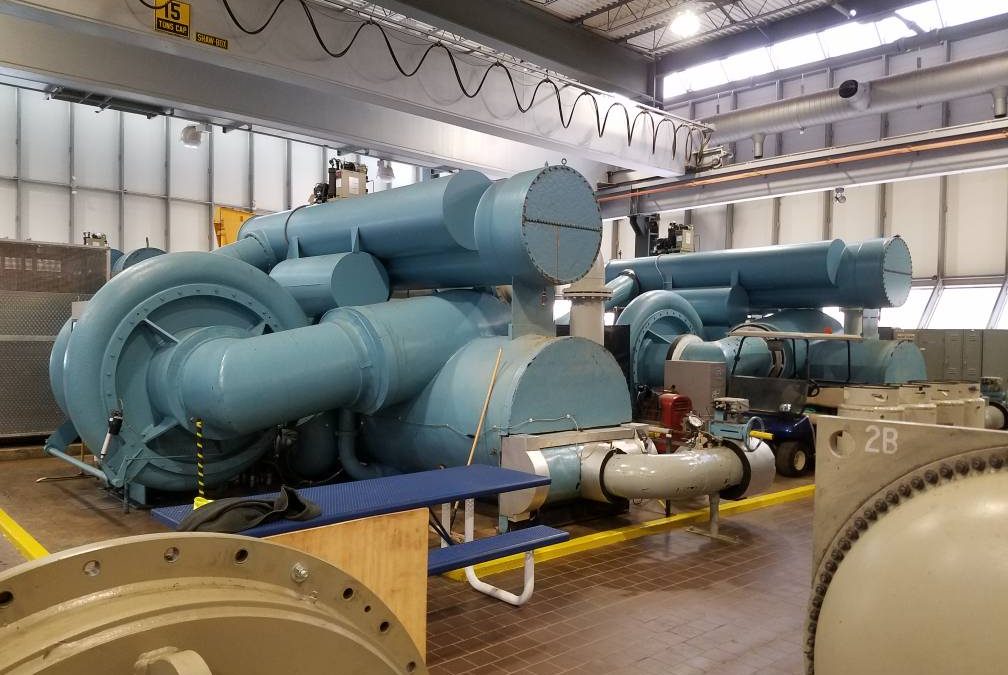Reciprocating Chillers:
A reciprocating compressor is used by reciprocating chillers, also known as piston chillers, to move refrigerant around the system. With this kind of compressor, the refrigerant is compressed by a piston that travels back and forth inside a cylinder, much like in an internal combustion engine.
· Advantages:
Reciprocating chillers are a great option for small-scale applications because of their reputation for efficiency at lesser cooling capacity. When compared to other types of chillers, they are typically more affordable up front, particularly for smaller installations. Reciprocating chillers are also prized for their longevity and dependable operation. Because they have fewer moving parts, there is a lower chance of mechanical failure, which adds to their solid reputation.
· Disadvantages:
Because reciprocating chillers rely on piston motion, which is a start-stop process, they have one drawback: frequent maintenance is needed. Higher long-term maintenance expenses may result from this. Additionally, these chillers have a considerable vibration and noise output, which could be problematic in areas where noise is a concern. Also, they are not as appropriate for larger-scale cooling requirements because they are usually restricted to applications requiring up to 200 tonnes of refrigeration (TR).
Screw Chillers:
A rotary screw compressor, used in screw chillers, is made up of two helical rotors that revolve in opposing directions. The refrigerant is forced through the gap between the rotors as they spin, compressing it. This kind of compressor is frequently employed in systems that must run continuously with little variation in load.
· Advantages:
Screw chillers are very efficient in a wide range of operating situations, especially when the cooling load fluctuates a lot. They are perfect for settings where noise reduction is crucial because they generate less vibration and noise than reciprocating chillers. Screw compressors can also be installed in spaces with limited space due to their small form.
· Disadvantages:
Compared to reciprocating chillers, screw chillers usually have higher initial costs. Because of its intricacy, maintenance and repairs necessitate the expertise of qualified experts, which may raise service charges. Screw chillers may use more energy than other types when working in partial load settings, depending on the particular application and operating environment.
Scroll Chillers:
The scroll compressor used in scroll chillers works with two interlocking spirals or scrolls. As the refrigerant passes through the spirals, one scroll stays in place while the other revolves around it, compressing it.
· Advantages:
Scroll chillers are built for continuous operation with low energy consumption and are incredibly efficient, especially in low-capacity applications. Compared to other compressor kinds, they have fewer moving parts, which means they require less maintenance and have fewer mechanical problems. Scroll chillers are also well-known for operating quietly, producing very little vibration and noise, which makes them appropriate for settings where noise pollution is an issue.
· Disadvantages:
Scroll chillers are usually only suitable for situations requiring smaller capacity—roughly 100 TR. Compared to reciprocating chillers with comparable capacity, they can be more costly despite their efficiency. Furthermore, under high ambient temperature situations, scroll chillers may have trouble dissipating heat, which could have a detrimental effect on their functionality.
Centrifugal Chillers:
A centrifugal compressor, which powers centrifugal chillers, accelerates refrigerant by spinning an impeller quickly. The refrigerant compresses against the compressor casing as it is accelerated and propelled outward.
· Advantages:
Centrifugal chillers are perfect for big commercial or industrial applications since they can handle cooling loads ranging from 200 TR to several thousand TR. When operating at maximum capacity, they consume very little energy and provide substantial operational savings for large-scale systems. Centrifugal chillers are generally lightweight and small despite having a considerable capacity, which makes installation and system integration easier.
· Disadvantages:
Centrifugal chillers’ biggest drawback is their expensive initial cost, which includes both purchase and maintenance. Nonetheless, the increased expenditure is frequently justified over time by the operating savings. Centrifugal chillers are complicated devices that need expert specialists to operate and maintain. They are best suited for situations where they can run close to or to full capacity because they are also less efficient under partial load circumstances.
FAQs:
1. What Are the Safety Considerations When Operating a Chiller?
Operating a chiller requires a high level of safety because it involves electrical components, massive gear, and high-pressure refrigerants. Important safety factors include maintaining enough ventilation in mechanical rooms, teaching staff on the safe operation of the chiller, and performing routine inspections and maintenance to prevent leaks or mechanical failures.
2. How Are Refrigerant Levels Controlled in a Chiller?
A chiller’s effective operation depends on maintaining the right refrigerant levels. Refrigerant imbalances can result in lower cooling efficiency, more energy usage, and even damage to the chiller. Refrigerant levels should be checked often, and any leaks should be fixed right away. Refrigerant may need to be topped off if the level is low, but only with the particular kind that has been approved for that particular chiller.
3. What is the Role of a Cooling Tower in a Water-Cooled Chiller System?
A cooling tower, which releases the heat the chiller absorbs into the atmosphere, is an essential part of a water-cooled chiller system. By moving water from the chiller’s condenser, where it absorbs heat, to the cooling tower, where air flows over it to cool it, the cooling tower circulates water. After cooling, the water is sent back into the chiller to absorb additional heat.


